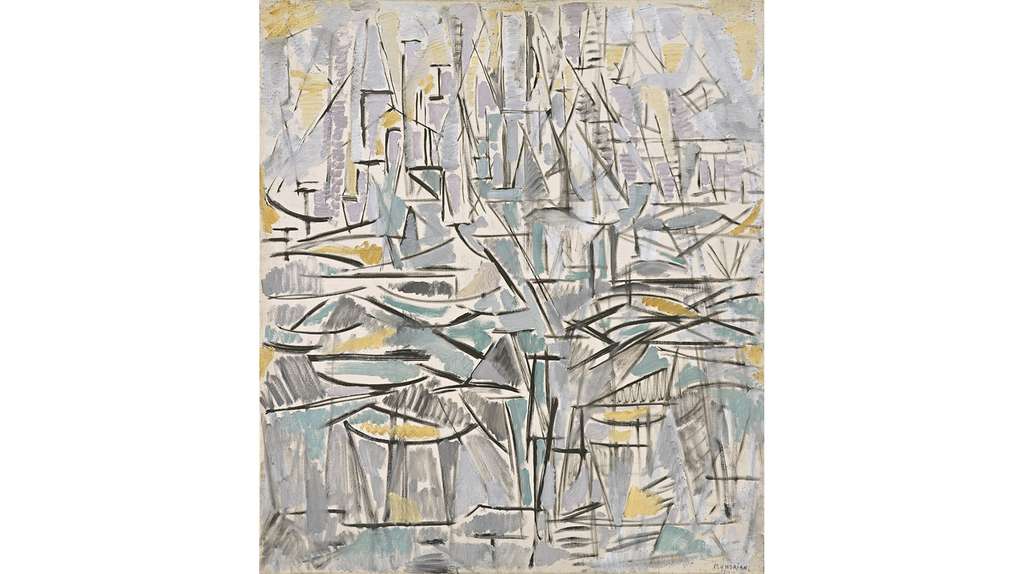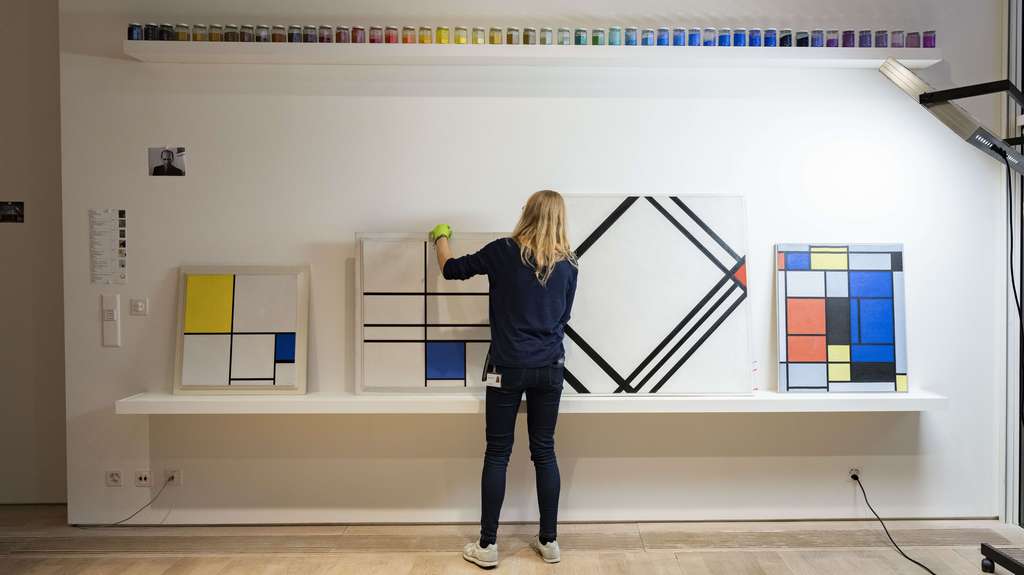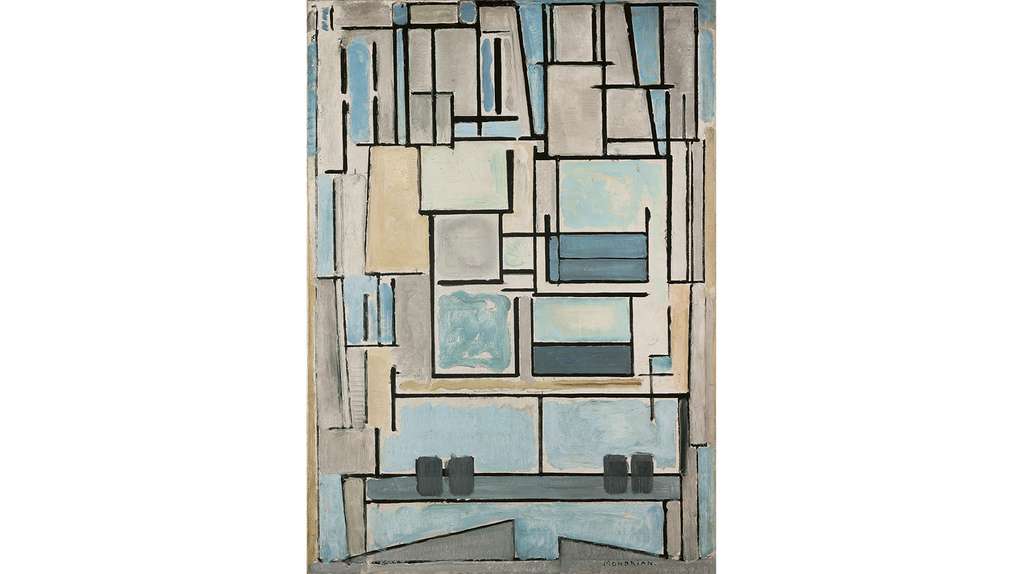Piet Mondrian, Eukalyptus, 1912
Trees are a key motif in Piet Mondrian’s work: as well as being an integral element of his early landscape paintings, they take on a particular importance, with the concentration on individual branches, in the creative phase that begins in 1911. From this point on, Mondrian’s paintings are increasingly characterized by Cubist influences. This stylistic reorientation was prompted by the artist’s first visit to Paris and by the first exhibition of the Moderne Kunstkring (Modern Art Circle) at the Stedelijk Museum in Amsterdam, where Mondrian saw works by Pablo Picasso and Georges Braque.
Eucalyptus (1912) provides a striking demonstration of Mondrian’s experiments with stylistic features of Cubism in the treatment of composition and color. Fragmenting the closed form of the motif and dissolving the contours, the artist arrives at a geometric abstraction of the eucalyptus, in which the basic structural features are recognizable as a dense thicket of black lines. Traditional perspective and the clear distinction between background and foreground are also abandoned. Instead, the multiple nuances of gray and the varying intensity of the color application create an impression of alternating density and transparency among the individual areas of the painting. Horizontal brushstrokes, heavily accented and clearly visible, alternate with patches of thick impasto, conferring a further element of structure on the picture. The color planes and the black lines partly overlap: color is no longer tied to contour, but is employed as an independent means of formal organization.
Images of the painting captured with various technical imaging techniques provide various information: visible light, raking light, transmitted light, UV fluorescent light, IR reflected light, IR transmitted light, X-ray.
The search for the composition
At first glance, Eucalyptus appears plainly constructed, with black lines and planes in various shades of gray. Research during the project showed that the painting process took place in several stages. In other words, Mondrian literally searched for the composition directly on the canvas. He began by making a sketch, and then applied a second paint layer. These two creative processes were then united in the final composition.
Sketching the composition directly on the canvas
Mondrian’s traditional artistic training in Amsterdam included making charcoal sketches on paper before executing a painting. He also drew these preliminary designs directly on his canvases. There is hardly a painting by Mondrian that did not begin with a charcoal sketch on the canvas in order to establish and work out the composition. This even applies to his later abstract works. The preliminary drawings were generally done in charcoal, which easily rubs off. Consequently, the process of developing the composition is often no longer fully traceable. Instead of using charcoal, Mondrian drew the preliminary study for the composition of Eucalyptus with a brush and heavily thinned black oil paint, applied in a way that suggests ink or watercolor. This first study for the composition could therefore be called an oil sketch.
Oil sketch
The oil sketch remains partly visible, and the paint application appears quick and hasty, as if the artist wanted to transfer his idea to the canvas as fast as possible. The sketch was rubbed off in places while still wet or scraped away and reworked later, after the color had dried. These corrections indicate that Mondrian revised the oil sketch several times, thereby developing and concretizing the composition. Unfortunately, this first composition is no longer fully discernible, even with the many methods of examination available today. Clearly, it would be of great interest to reconstruct how Mondrian developed his composition in this key phase of his work, during the transition from figuration to an abstract, Cubist style.
An approximate impression of how the original oil sketch could have been executed, and of its possible appearance, is provided by a further sketch in oil, also executed on canvas, that bears the same title, Eucalyptus and dates, like its companion, from 1912. This work, which is considered to be unfinished, was not overpainted any further, and therefore provides a good insight into the sketching process.
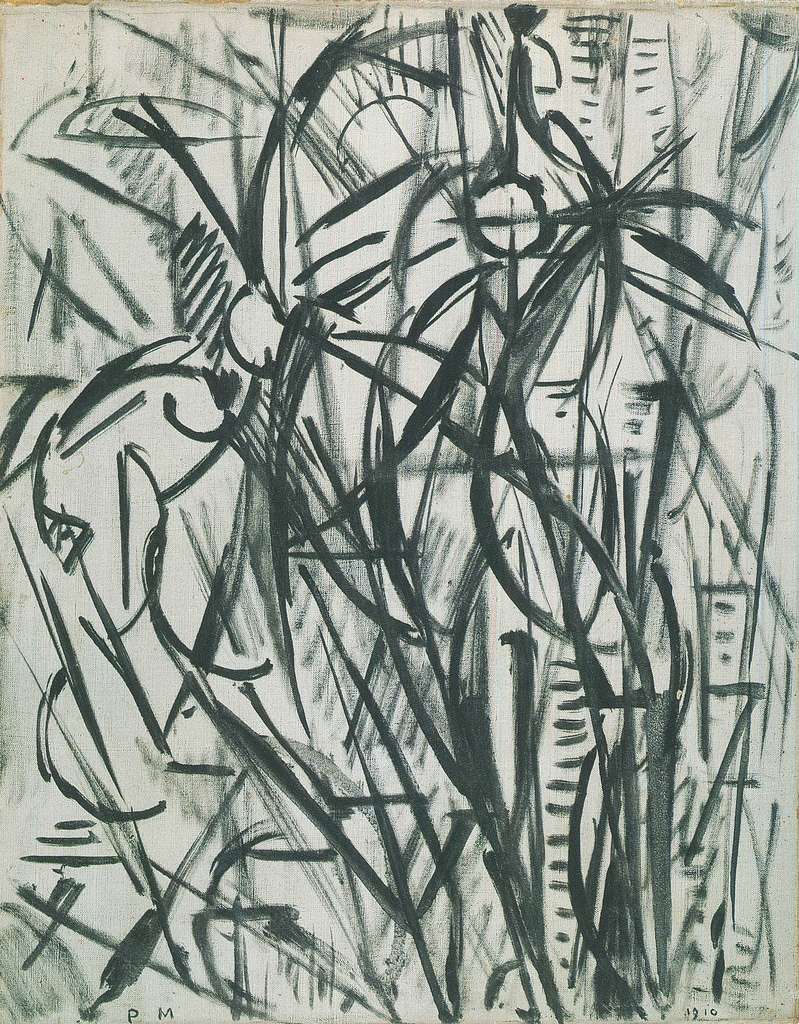
Combining the oil sketch with the paint layer
In a second step, Mondrian used a range of mixed gray oil paints, applied more thickly and with heavier impasto than in the underlying oil sketch.
Nearly all of the planes between the black lines are filled with the gray colors. In the process, many of the black lines were also completely overpainted, but a number of them remained visible. Thus Mondrian integrates the oil sketch into the final composition, instead of using it as a mere reference.
In a last step conclusion, Mondrian added a few more black lines to accentuate the finished composition. These further black brushstrokes seem barely distinguishable from those ofin the oil sketch. However, closer examination by microscope reveals that the black in the sketch is more matt, with a warmer tone than the layers of black applied later. The X-ray image also helps to establish a clear distinction between these two steps in the painting process: unlike the black in the upper layer of paint, the paintcolor ofin the sketch is no longer visibledoes not appear. This is because two distinct mixtures of pigments have been used, which absorb the X-rays differently. The difference in the choice of materials indicates that Mondrian worked in two separate steps, in accordance with the classical notion of the sketch as an artistic step in its own right. In Eucalyptus, however, Mondrian translates the preparatory sketch into the medium of painting and then unites it within the final composition.
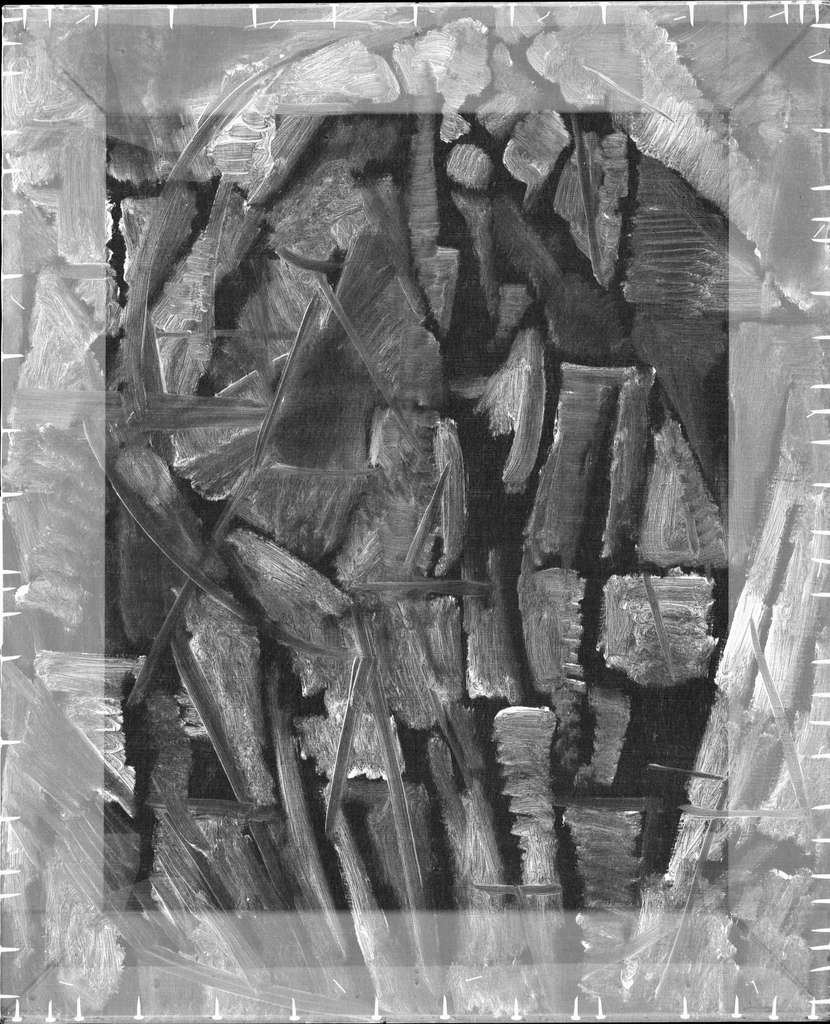
X-ray image of the painting: the black lines of the oil sketch do not show up, in contrast to the black color of the top paint layer. This results from the use of different pigment mixtures
Mondrian and the frame
Framing, for Mondrian, was an important element of his paintings and played a relevant part in his theory of art. This led to the creation of the unmistakable strip frames and subframes on his best-known works. Especially in his later work, the framing elements became an integral part of the picture, making them even physically inseparable from the painting. However, many of his works are no longer mounted in their original frames. Extensive research is needed to attempt a reconstruction. Eucalyptus illustrates the process of finding a frame.
A new framing format
Mondrian’s early figurative and Cubist works were mounted in traditional “rebate” frames, generally dark or bronze-colored, with various simple profiles. A frame of this type always covers a small part of the picture surface along the edges; the painting itself rests in the recess, known as a rebate or rabbet (a, b), and the frame therefore has the visual effect of a window containing the work.
From 1914, when Mondrian’s works became increasingly abstract, he sought a new method of framing that reducedto reduce thise border effect. He began by nailing thin strips of wood to the edges margins of the paintingscanvas, to make aplacing them frame that fitted flush with the picture surface plane (c). This made kept the entire painticture surface visible, and to avoided enclosing the works or endowing them with a sense of depth. In an interview, Mondrian claimed to have been the first artist to frame his pictures in this way:
“So far as I know, I was the first to bring the painting forward from the frame, rather than set it within the frame. I had noted that a picture without a frame works better than a framed one and that the framing causes sensations of three dimensions. It gives an illusion of depth …” (quoted in James Johnson Sweeney “Eleven Europeans in America,” The Bulletin of Modern Art 13, 4/5, 1946, p. 35–36)
In 1920 Mondrian even insisted on showing his pictures unframed. To protect the fragile works and make them easier to handle, he later returned to using strip frames, but now setting the strips more towards the back of the margins, away from the surface (d), thus avoiding any bordering affect.
Mondrian often framed his paintings only when they were due to be exhibited, and framed groups of his works similar, so that they created a unified impression. Consequently, there are some original frames that, together with the paintings, are associated with a particular exhibition or owner. In 1928 Mondrian took his approach to framing a step further with the use of subframes, attached like a board to the back of the painting, sometimes in conjunction with strip frames(e). From 1937 on, he used only this type of framing.
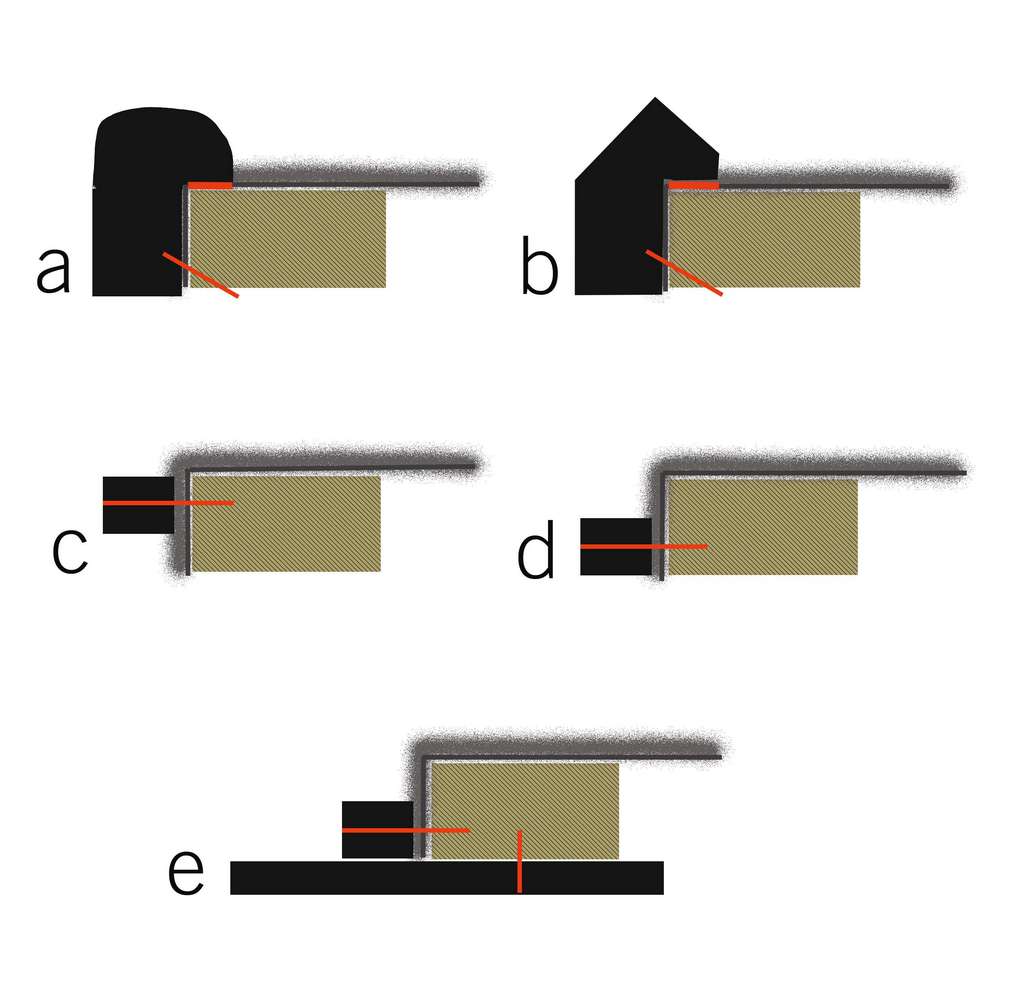
The various frame formats used by Mondrian, and the traces (marked in red) they could leave on the painting:
a rebate frame, semi-rounded profile
b rebate frame, polygonal profile
c strip frame nailed to the side of the canvas, flush with the paint layer
d strip frame nailed to the side of the canvas, set back
e subframe (attached to the verso) and strip frame nailed to the side of the canvas, set back
Research on lost frames
Over the years, many original frames were removed, altered, replaced or overpainted, so that in some cases the artist’s intention with regard to framing is no longer apparent. As part of the Piet Mondrian Conservation Project it will be attempted to reconstruct lost frames on the basis of the following information:
- Historical images of the works
- Physical traces of original framing on the paintings
- Comparison with original frames of works by Mondrian from the same period
- References to frames in Mondrian’s letters
History of the framing of Eucalyptus
Eucalyptus no longer has its original frame. The first historical images of the work date from 1953, when it was shown in an exhibition at the Sidney Janis Gallery, New York. Here, the painting has a set-back strip frame, made of white wooden strips, and a white subframe. In a photograph from 1976, the work is seen in Ernst Beyeler’s house, now with a wider strip frame, also in white. For the opening of the Fondation Beyeler in 1997, the framing was changed again, by placing the picture under glass in a protective box frame.
At the time of painting Eucalyptus, Piet Mondrian was still using traditional rebate frames. From old photographs and the few surviving original frames it can be seen that the profiles of these frames were flat, rounded or polygonal. Photographs of these frames were digitally combined with an image of Eucalyptus. Comparing the results, Eucalyptus looks somewhat different in each of these frames, highlighting the importance of careful, research-backed assessment to any reconstruction project involving picture frames.
The painting itself unfortunately provides no evidence from which definite conclusions can be drawn about the original framing. The successive mountings on various frames have left different traces on the work. Nail holes in the margins of the canvas were probably caused by strip framing. The holes can be seen at the top, middle and bottom of the margins (c, d), in the customary way that strips would be nailed to the side of a painting. Symmetrically located holes in the verso of the stretcher could be traced to at least four different frames to which the work might have been attached (a, b, e).
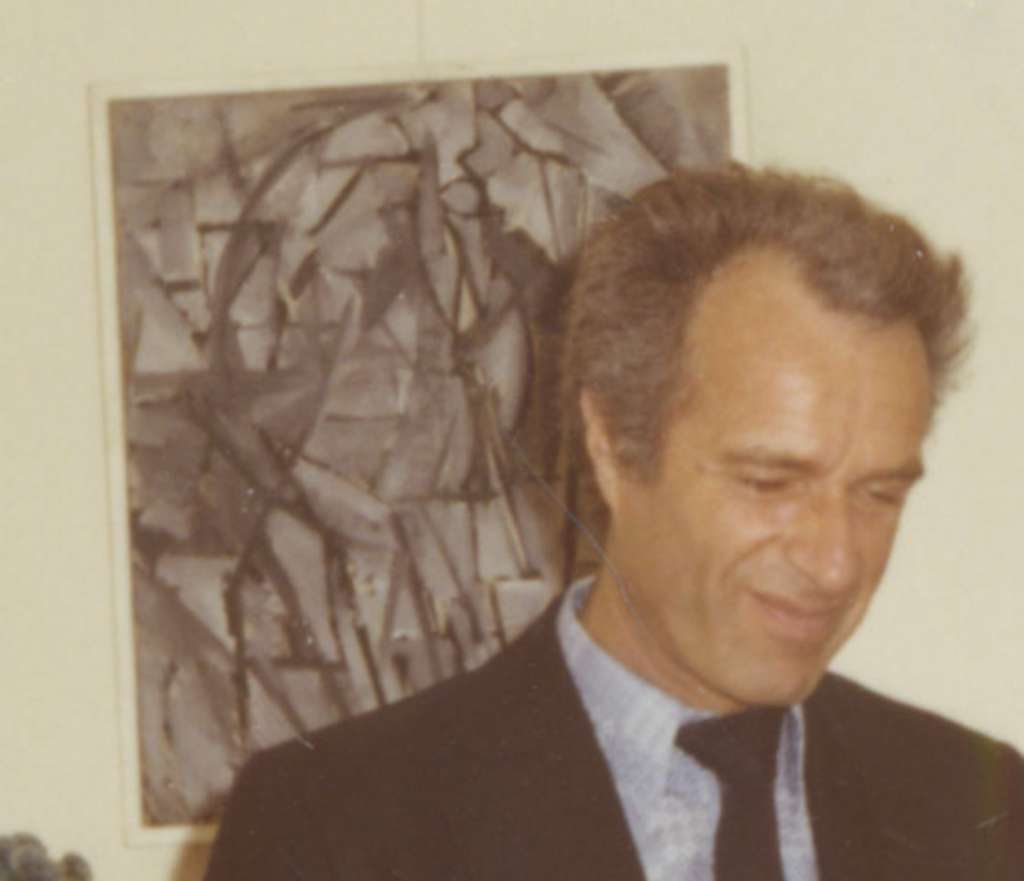
What type of frame did Mondrian intend to use for Eucalyptus?
There is no clear answer to the question as to Mondrian’s choice of frame for the picture. It is possible that the work had no frame at all when it was completed in 1912, after which it remained in the artist’s studio and was not exhibited until 1942. Would Mondrian have framed the finished painting in the absence of any plan to exhibit the work? Would he have opted for a rebated frame in 1942?
In 1912, this type of frame would have been customary for him. Or would he have preferred a frame in keeping with his characteristic style of framing in the 1940s? In the course of the project, Eucalyptus will be fitted with a variety of frames, and the results will be reviewed by the team. The choice of frame will also be guided by the question of the frames to be used with the other six pictures in the Beyeler collection and how they can be combined with protective measures, such as fitting protective glazing.

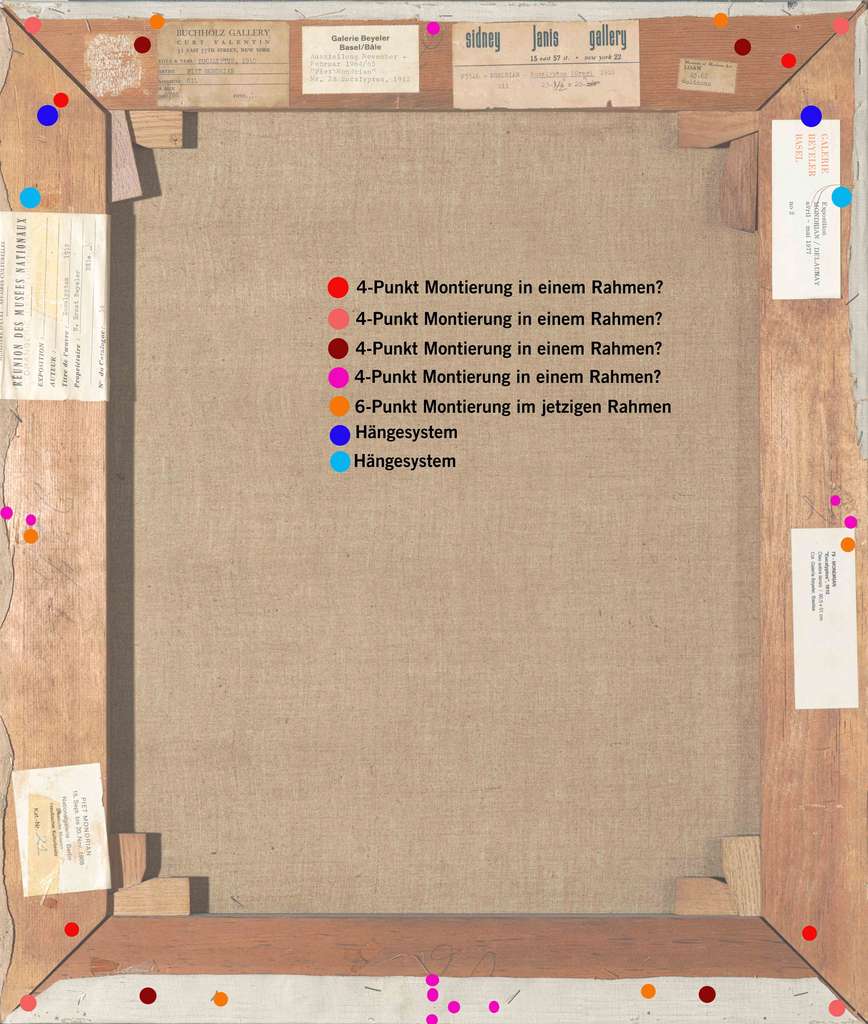
Above: Side view of the top edge; the angular holes marked in gray are from an older stretching. The holes marked in red indicate two different mountings of strip frames
Below: Judging by the symmetrically located groups of holes in the verso, the work could have been mounted in four different frames, nailed or screwed to the back. The holes marked in blue are from earlier hanging systems
Explore more works
Composition No. XVI
(Compositie I, Arbres)
Despite the geometric structure of Composition No. XVI, the generally fine lines and sketch-like application of color make the picture light and transparent.
Return to overview
Get an overview of the Piet Mondrian Conservation Project and the seven works being examined.
Composition No. VI
(Compositie 9, Blue Façade)
In Composition No. VI Piet Mondrian is more interested in the structural characteristics and colors of the house as sources of inspiration than in its figurative representation.
